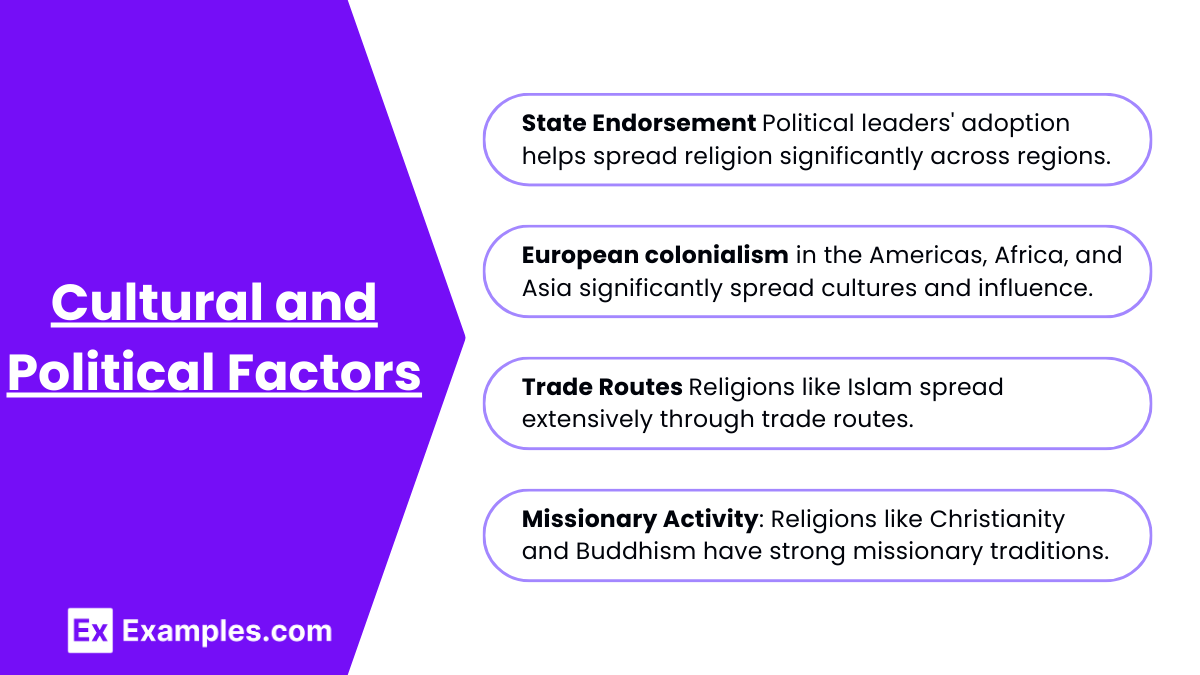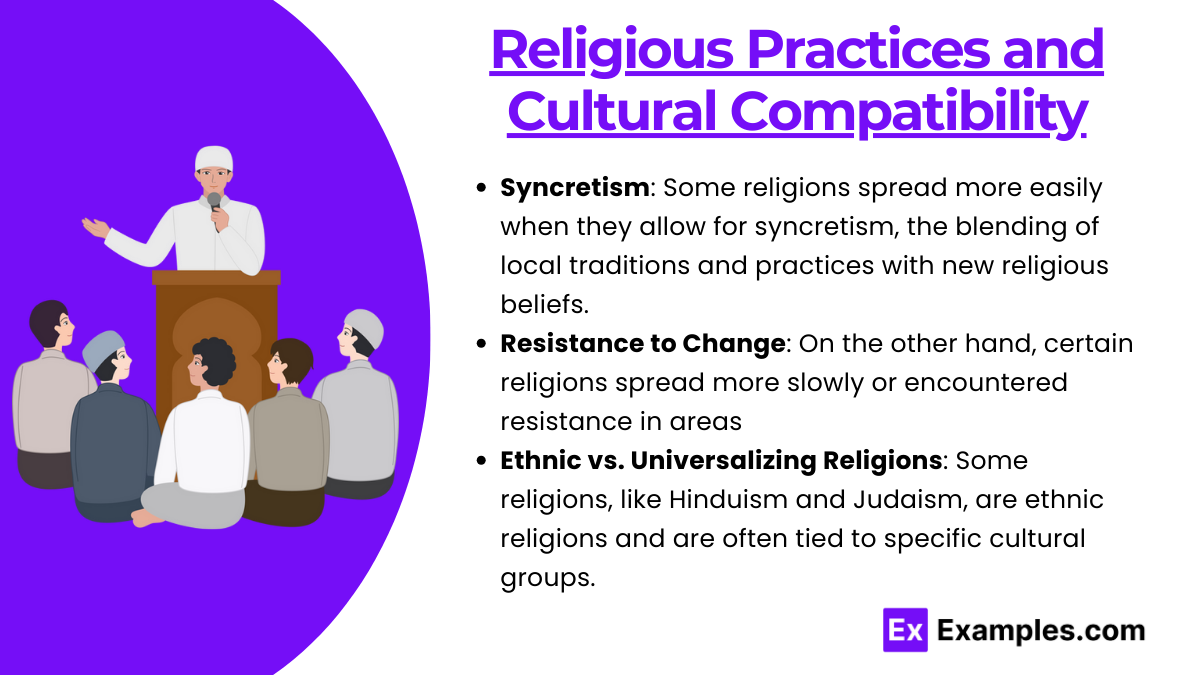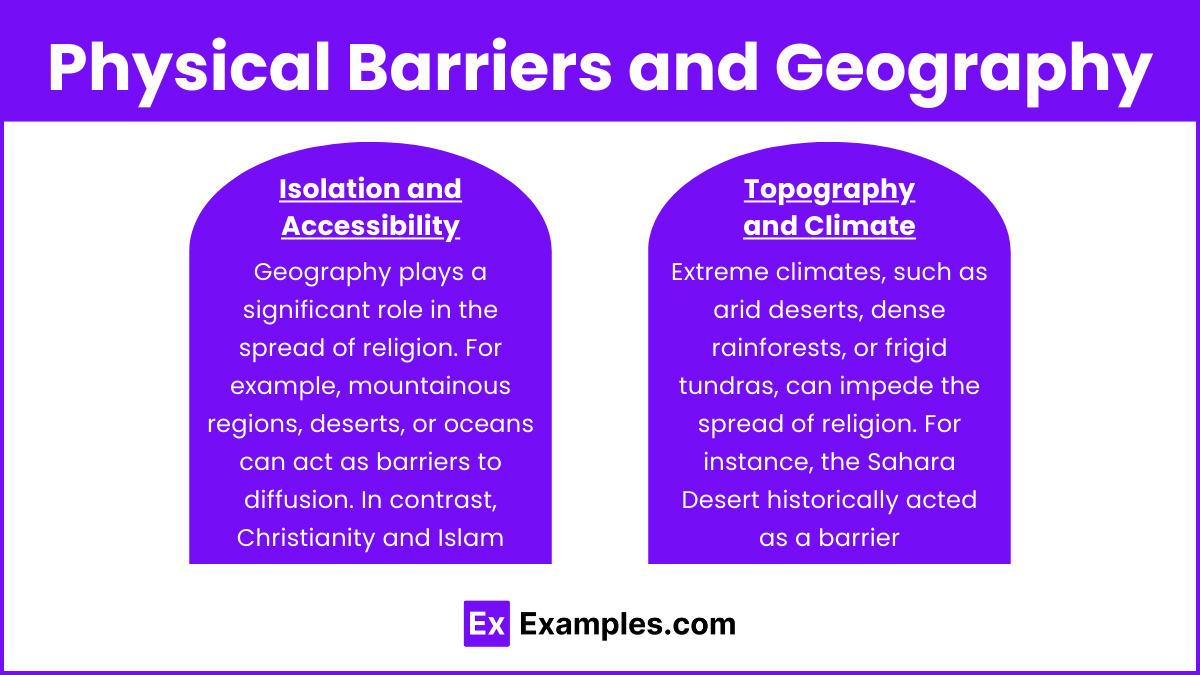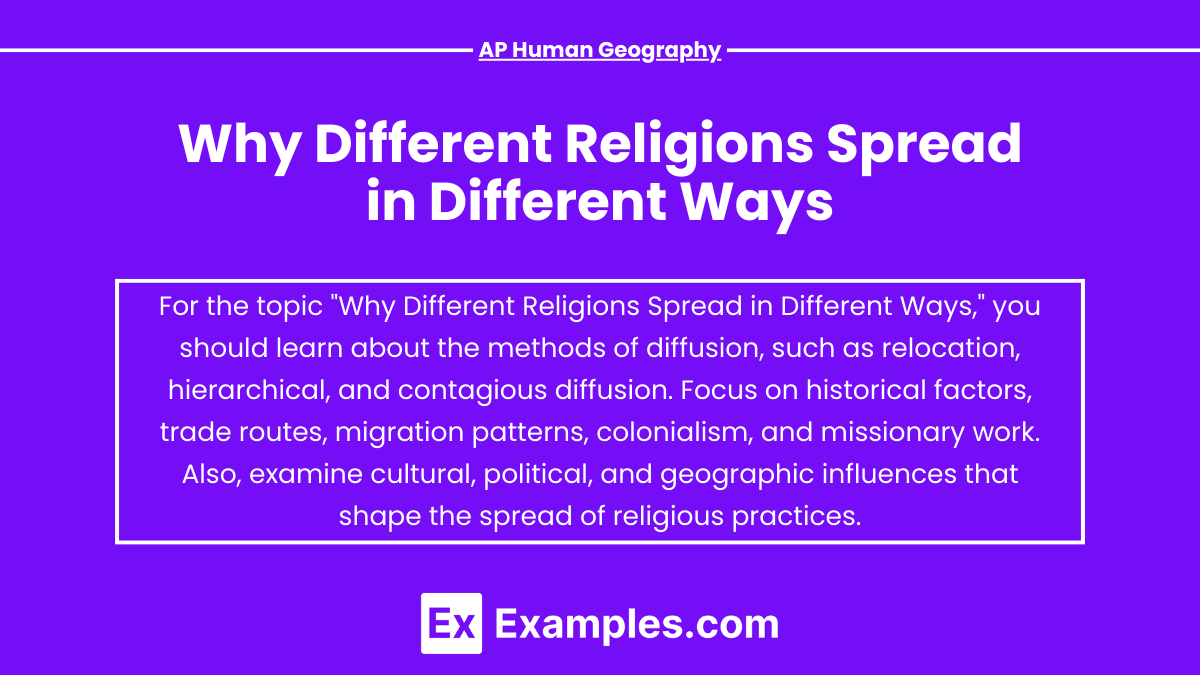The spread of different religions across the world is influenced by various cultural, historical, and geographical factors in AP Human Geography. Religions like Christianity, Islam, and Buddhism often spread through trade routes, political endorsement, and missionary work, while others, such as Hinduism and Judaism, remain more localized due to cultural ties and geographical barriers. Factors like syncretism, colonialism, and technology further shape the diffusion process. Understanding these patterns in AP Human Geography helps explain why some religions become globalized while others retain a regional or ethnic focus.
Learning Objectives
When studying “Why Different Religions Spread in Different Ways” for AP Human Geography, you should focus on understanding the various diffusion methods (relocation, hierarchical, and contagious) that impact religious spread. Learn how political, cultural, and historical factors like colonialism, trade routes, and missionary activity influence diffusion patterns. Explore how geographic barriers, cultural compatibility, and ethnic versus universalizing religions shape the spread of beliefs. Additionally, study the role of social networks, diaspora communities, and modern technology in the global spread of religions.
Religions spread in different ways due to several historical, cultural, and geographical factors, each shaping the paths and patterns of religious diffusion. Here’s an in-depth explanation of why different religions spread in different ways:
Mechanisms of Diffusion

- Relocation Diffusion: Some religions, like Christianity and Islam, initially spread through relocation diffusion, where believers moved to new regions, bringing their faith with them. For example, early Christianity spread as missionaries traveled to different parts of the Roman Empire.
- Hierarchical Diffusion: In hierarchical diffusion, religion spreads from influential leaders or places to other areas. For example, Christianity was adopted by the Roman Emperor Constantine and later spread through rulers adopting the religion and promoting it throughout their territories. Similarly, Buddhism spread when rulers like Ashoka endorsed it.
- Contagious Diffusion: This happens when religion spreads rapidly through close contact between individuals, often in densely populated areas. Islam spread in part through contagious diffusion across the Arabian Peninsula through trade routes and interactions between people.
Cultural and Political Factors

- State Endorsement: The adoption of religion by political leaders or states can play a crucial role in how a religion spreads. In many cases, such as with the Roman Empire’s adoption of Christianity or the Ottoman Empire’s spread of Islam, state support enabled widespread diffusion.
- Colonialism: European colonialism in the Americas, Africa, and Asia was a major factor in spreading Christianity. Missionaries often accompanied colonial expeditions, and the religion was imposed on indigenous populations. In contrast, other religions like Hinduism and Buddhism were more locally contained because they did not spread through imperial conquest in the same way.
- Trade Routes: Religions like Islam spread extensively through trade routes. Muslim traders played a critical role in spreading Islam to Sub-Saharan Africa, Southeast Asia, and even parts of Europe. Hinduism and Buddhism also spread via the Silk Road and maritime trade routes to Southeast Asia.
- Missionary Activity: Religions like Christianity and Buddhism have strong missionary traditions. Christian missionaries traveled across the world, and Buddhist monks similarly spread their teachings throughout Asia.
Religious Practices and Cultural Compatibility

- Syncretism: Some religions spread more easily when they allow for syncretism, the blending of local traditions and practices with new religious beliefs. For example, when Buddhism spread in East Asia, it blended with local beliefs like Confucianism and Taoism in China or Shinto in Japan.
- Resistance to Change: On the other hand, certain religions spread more slowly or encountered resistance in areas where local cultural practices were deeply ingrained. For instance, Hinduism, which is deeply connected to specific cultural practices in India, has remained relatively confined to South Asia compared to universalizing religions like Christianity or Islam.
- Ethnic vs. Universalizing Religions: Some religions, like Hinduism and Judaism, are ethnic religions and are often tied to specific cultural groups. These religions spread less through conversion and more through birth and cultural continuity. In contrast, universalizing religions like Christianity, Islam, and Buddhism seek converts and are more likely to spread to diverse populations.
Physical Barriers and Geography

- Isolation and Accessibility: Geography plays a significant role in the spread of religion. For example, mountainous regions, deserts, or oceans can act as barriers to diffusion. Hinduism, largely confined to the Indian subcontinent, encountered natural barriers that limited its expansion beyond South Asia. In contrast, Christianity and Islam, which emerged in the Middle East, were able to spread more widely due to their proximity to trade routes and the Mediterranean Sea.
- Topography and Climate: Extreme climates, such as arid deserts, dense rainforests, or frigid tundras, can impede the spread of religion. For instance, the Sahara Desert historically acted as a barrier between North Africa and Sub-Saharan Africa, slowing the diffusion of Islam into the latter until the development of more efficient camel caravans. Similarly, the dense Amazon rainforest has historically limited the penetration of Christianity into remote indigenous communities in South America. In contrast, temperate and coastal regions with favorable climates and accessible transportation routes often facilitate the spread of religions through easier travel and trade.
Examples
Example 1. Christianity’s Spread through Roman Empire and Colonialism
Christianity initially spread through relocation and hierarchical diffusion within the Roman Empire. Missionaries like Paul traveled extensively, establishing early Christian communities. The conversion of Emperor Constantine further facilitated its spread through hierarchical diffusion, as the Roman Empire endorsed Christianity. Centuries later, European colonial powers, particularly Spain and Portugal, spread Christianity to the Americas, Africa, and parts of Asia through missionary activity, integrating religious diffusion with political and economic expansion.
Example 2. Islam’s Spread via Trade and Conquest
Islam spread rapidly after its founding through both contagious diffusion and hierarchical diffusion. Early Islamic conquests extended from the Arabian Peninsula into North Africa, Spain, and the Middle East. Additionally, Muslim traders played a significant role in spreading Islam to regions like Sub-Saharan Africa and Southeast Asia through trade routes. This allowed Islam to spread both through direct conquest and through peaceful exchange along trading hubs, particularly in coastal and port cities.
Example 3. Buddhism’s Spread through Missionaries and Trade
Buddhism spread primarily through relocation and contagious diffusion, supported by missionary efforts. After Emperor Ashoka of the Mauryan Empire converted to Buddhism, he sent missionaries to spread the religion across Asia. Buddhism reached China, Korea, and Japan via the Silk Road and maritime routes. Unlike Christianity and Islam, which spread through conquest, Buddhism often spread through peaceful means, adapting to local customs and blending with other religions like Confucianism and Taoism in East Asia.
Example 4. Hinduism’s Containment in South Asia
Hinduism is an ethnic religion primarily tied to the Indian subcontinent. Unlike universalizing religions like Christianity or Islam, Hinduism did not actively seek converts. It spread mainly through relocation diffusion within India and neighboring regions like Nepal and Bali, where migration patterns supported its diffusion. Geographic barriers like the Himalayas and the Indian Ocean limited its expansion, and its deep ties to Indian culture and society also made it less likely to diffuse globally.
Example 5. Judaism and the Jewish Diaspora
Judaism, another ethnic religion, spread mainly through relocation diffusion, especially as Jewish communities were displaced due to persecution. The Jewish diaspora saw Jewish populations move across Europe, North Africa, and the Middle East. Despite their geographic dispersion, Jewish communities maintained their religious identity and practices. Unlike universalizing religions, Judaism’s spread is less about seeking converts and more about maintaining religious cohesion within a dispersed ethnic group.
Multiple Choice Questions
Question 1
Which of the following best describes hierarchical diffusion in the spread of religion?
A) A religion spreads from one individual to another through close contact.
B) A religion spreads as it is adopted by political leaders or influential figures.
C) A religion spreads by followers relocating to new areas and sharing their beliefs.
D) A religion spreads by blending with local traditions and practices.
Answer: B) A religion spreads as it is adopted by political leaders or influential figures.
Explanation: Hierarchical diffusion refers to the spread of a religion or idea from more powerful or influential people down to others. For example, when rulers such as Constantine of the Roman Empire or King Ashoka in India adopted Christianity and Buddhism, respectively, their endorsement significantly boosted the spread of these religions. This contrasts with contagious diffusion (option A), where a religion spreads person-to-person, or relocation diffusion (option C), where a religion spreads because followers move to new areas. Syncretism, the blending of religions, relates to option D.
Question 2
What role did trade routes play in the spread of Islam?
A) Trade routes isolated Islamic communities, limiting the religion’s spread.
B) Trade routes facilitated the spread of Islam primarily through missionary work.
C) Trade routes helped spread Islam by connecting Muslim traders with new regions.
D) Trade routes were irrelevant to the spread of Islam as it spread primarily through warfare.
Answer: C) Trade routes helped spread Islam by connecting Muslim traders with new regions.
Explanation: Islam spread significantly through trade routes, as Muslim traders traveled across the Middle East, North Africa, and parts of Asia. These traders established relationships with local communities, and their faith spread through these interactions. This form of diffusion is both contagious and relocation-based. Trade routes like the Silk Road and Indian Ocean trade networks were crucial in the spread of Islam to Sub-Saharan Africa, Southeast Asia, and other distant regions. While warfare did play a role in some areas, trade routes were essential in spreading Islam peacefully (option D is incorrect).
Question 3
Why have some ethnic religions, like Hinduism, not spread as widely as universalizing religions?
A) Ethnic religions are tied to specific cultural groups and do not seek to convert others.
B) Ethnic religions lack political or economic support from influential governments.
C) Ethnic religions are only practiced by isolated communities with no interaction with outsiders.
D) Ethnic religions spread through missionary work, but the missionaries often face persecution.
Answer: A) Ethnic religions are tied to specific cultural groups and do not seek to convert others.
Explanation: Ethnic religions, like Hinduism and Judaism, are closely tied to specific ethnic or cultural groups and do not actively seek converts, which limits their geographic spread. This is in contrast to universalizing religions, such as Christianity, Islam, and Buddhism, which actively seek to convert people from all cultural backgrounds, enabling them to spread more widely. Option B is incorrect because political or economic support can still exist for ethnic religions, and option C is incorrect because ethnic religions can be practiced in global diasporas. Option D misrepresents the nature of ethnic religions, as they typically do not focus on missionary work.


